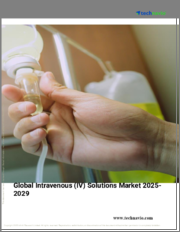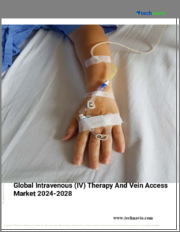
|
시장보고서
상품코드
1698094
세계의 정맥내(IV) 기기 시장 : 산업 규모, 점유율, 동향, 기회, 예측, 부문 유형별, 최종사용자별, 지역별, 경쟁, 2020-2030FIntravenous Equipment Market - Global Industry Size, Share, Trends, Opportunity, and Forecast, Segmented Type, By End-User, By Region & Competition, 2020-2030F |
||||||
정맥내(IV) 기기 세계 시장 규모는 2024년 135억 7,000만 달러로 평가되었고, 2030년까지 5.27%의 연평균 복합 성장률(CAGR)을 나타내며 예측 기간 동안 강력한 성장을 보일 것으로 예상됩니다.
세계 정맥 내(IV) 기기 시장은 광범위한 헬스케어 산업에서 역동적이고 빠르게 발전하고 있는 분야로, 환자 관리 및 치료에 있어 매우 중요한 역할을 하고 있습니다. 정맥 내 치료는 정맥을 통해 혈액의 흐름에 직접적으로 수분, 약물, 영양분을 투여하는 것으로, 해당 장비에는 이 과정을 촉진하기 위해 고안된 다양한 장비가 포함됩니다. 이 시장은 만성 질환 증가, 고령화, 전 세계 수술 건수 증가 등을 배경으로 혁신적이고 진보된 수액 주입 장비에 대한 수요가 증가하고 있는 것이 특징입니다. 예를 들어, 2021년 4월 발표된 세계보건기구(WHO) 자료에 따르면, 만성질환은 연간 4,100만 명의 사망을 유발하며, 전 세계 사망자의 71%를 차지할 것으로 예측되고 있습니다. 또한, 중저소득 국가 사망률의 77%는 만성질환으로 인한 것입니다. 암 환자 및 기타 만성질환 증가에 따라 다양한 수술에 대한 수요가 증가하여 시장 성장의 원동력이 될 것으로 예상됩니다.
| 시장 개요 | |
|---|---|
| 예측 기간 | 2026-2030년 |
| 시장 규모 : 2024년 | 135억 7,000만 달러 |
| 시장 규모 : 2030년 | 183억 2,000만 달러 |
| CAGR : 2025-2030년 | 5.27% |
| 급성장 부문 | 주입 펌프 |
| 최대 시장 | 북미 |
정맥내(IV) 기기 세계 시장 성장의 주요 요인으로는 당뇨병, 암, 심혈관 질환과 같은 질병의 발생률 증가로 인해 효율적이고 정확한 약물 전달 메커니즘이 요구되고 있습니다. 전 세계 의료 시스템이 환자의 예후를 개선하고 입원 기간을 최소화하는 데 집중하면서 수액 요법에 대한 수요가 급증하고 있습니다. 스마트팜프, 안전 수액 시스템, 무선 연결과 같은 주입 장비의 기술 발전은 약물 투여의 정확성과 안전성을 향상시켜 시장 확대를 더욱 촉진하고 있습니다.
주요 시장 성장 촉진요인
만성질환 유병률 증가
주요 시장 이슈
비용 제약과 저렴한 가격
주요 시장 동향
환자 중심의 헬스케어에 집중
목차
제1장 개요
제2장 조사 방법
제3장 주요 요약
제4장 세계의 정맥내(IV) 기기 시장 전망
- 시장 규모와 예측
- 금액별
- 시장 점유율과 예측
- 유형별(IV 카테터, 주입 펌프, 고정 장치, 투여 세트, 점적 챔버, 기타 유형)
- 최종사용자별(병원, 외래수술센터(ASC), 기타 최종사용자)
- 지역별
- 기업별(2024년)
- 시장 맵
- 유형별
- 최종사용자별
- 지역별
제5장 아시아태평양의 정맥내(IV) 기기 시장 전망
- 시장 규모와 예측
- 금액별
- 시장 점유율과 예측
- 유형별
- 최종사용자별
- 국가별
- 아시아태평양 : 국가별 분석
- 중국
- 인도
- 호주
- 일본
- 한국
제6장 유럽의 정맥내(IV) 기기 시장 전망
- 시장 규모와 예측
- 시장 점유율과 예측
- 유럽 : 국가별 분석
- 프랑스
- 독일
- 스페인
- 이탈리아
- 영국
제7장 북미의 정맥내(IV) 기기 시장 전망
- 시장 규모와 예측
- 시장 점유율과 예측
- 북미 : 국가별 분석
- 미국
- 멕시코
- 캐나다
제8장 남미의 정맥내(IV) 기기 시장 전망
- 시장 규모와 예측
- 시장 점유율과 예측
- 남미 : 국가별 분석
- 브라질
- 아르헨티나
- 콜롬비아
제9장 중동 및 아프리카의 정맥내(IV) 기기 시장 전망
- 시장 규모와 예측
- 시장 점유율과 예측
- 중동 및 아프리카 : 국가별 분석
- 남아프리카공화국
- 사우디아라비아
- 아랍에미리트(UAE)
- 이집트
제10장 시장 역학
- 성장 촉진요인
- 과제
제11장 시장 동향과 발전
- 최근 동향
- 제품 출시
- 인수합병(M&A)
제12장 세계의 정맥내(IV) 기기 시장 : SWOT 분석
제13장 Porter의 Five Forces 분석
- 업계내 경쟁
- 신규 참여 가능성
- 공급업체의 힘
- 고객의 힘
- 대체품의 위협
제14장 경쟁 구도
- 3D Systems, Inc.
- 3M Company
- Baxter International
- Becton, Dickinson and Company
- B. Braun Melsungen AG
- EuroLife Healthcare Pvt. Ltd
- Henry Schein, Inc
- ICU Medical, Inc
- Polymedicure
- Terumo Corporation
- Teleflex Incorporated
제15장 전략적 제안
제16장 리서치사에 대해 & 면책사항
LSH 25.04.22Global Intravenous (IV) Equipment Market was valued at USD 13.57 billion in 2024 and is anticipated to project robust growth in the forecast period with a CAGR of 5.27% through 2030. The Global Intravenous (IV) Equipment Market is a dynamic and rapidly evolving sector within the broader healthcare industry, playing a pivotal role in patient care and treatment. Intravenous therapy involves the administration of fluids, medications, and nutrients directly into the bloodstream through a vein, and the corresponding equipment encompasses a wide range of devices designed to facilitate this process. The market is characterized by a growing demand for innovative and advanced IV equipment, driven by the increasing prevalence of chronic diseases, the aging population, and the rising number of surgical procedures globally. For instance, according to data from the World Health Organization published in April 2021, chronic diseases are projected to cause 41 million deaths annually, accounting for 71% of all global deaths. Additionally, 77% of mortality in low- and middle-income countries is attributed to chronic diseases. As the number of cancer cases and other chronic conditions rise, the demand for various surgical procedures is expected to increase, driving market growth.
| Market Overview | |
|---|---|
| Forecast Period | 2026-2030 |
| Market Size 2024 | USD 13.57 Billion |
| Market Size 2030 | USD 18.32 Billion |
| CAGR 2025-2030 | 5.27% |
| Fastest Growing Segment | Infusion Pumps |
| Largest Market | North America |
Key factors contributing to the growth of the Global Intravenous Equipment Market include the escalating incidence of diseases such as diabetes, cancer, and cardiovascular disorders, necessitating efficient and precise drug delivery mechanisms. As healthcare systems worldwide focus on improving patient outcomes and minimizing hospital stays, the demand for intravenous therapies has surged. The technological advancements in IV equipment, such as smart pumps, safety infusion systems, and wireless connectivity, have enhanced the accuracy and safety of drug administration, further fueling market expansion.
Key Market Drivers
Rising Prevalence of Chronic Diseases
The rising prevalence of chronic diseases is a pivotal factor driving the robust growth of the Global Intravenous (IV) Equipment Market. Chronic diseases, including diabetes, cardiovascular disorders, and cancer, have witnessed a significant surge in incidence worldwide. These conditions often necessitate long-term and intricate medical interventions, with intravenous therapy emerging as a crucial component of their management. The prevalence of chronic diseases is influenced by factors such as sedentary lifestyles, aging populations, and changes in dietary habits. As a result, there is an escalating demand for advanced and efficient intravenous solutions and equipment to facilitate the administration of medications and fluids required for the treatment of chronic conditions. For instance, according to the Alzheimer Society of Canada, over 500,000 Canadians were living with dementia as of January 2021, with the number expected to increase to 912,000 by 2030. Similarly, the Fondation de France reported that around 150,000 people in France were affected by Parkinson's disease in 2021, with the disease predominantly impacting the elderly. As the prevalence of chronic diseases rises, the demand for related healthcare solutions is expected to drive market growth in the coming years.
Key Market Challenges
Cost Constraints and Affordability
Cost constraints and affordability represent significant hurdles for the Global Intravenous (IV) Equipment Market, posing challenges to the widespread adoption of advanced intravenous technologies. The intricate and innovative nature of modern IV equipment, including infusion pumps, smart catheters, and monitoring systems, often comes with a hefty price tag. This presents a barrier for healthcare facilities, particularly in resource-limited regions, where financial constraints impede the seamless integration of state-of-the-art IV solutions.
One of the primary obstacles is the high initial investment required for acquiring advanced IV equipment. Hospitals and healthcare providers, particularly those in developing countries, often operate on tight budgets, making it challenging to allocate substantial funds for the purchase of cutting-edge IV technologies. The upfront costs for these devices can strain financial resources, limiting the ability of healthcare facilities to invest in the latest innovations that could otherwise enhance patient care and safety.
Key Market Trends
Focus on Patient-Centric Healthcare
The Global Intravenous (IV) Equipment Market is experiencing a significant boost due to a pronounced shift towards patient-centric healthcare. This transformative trend places the patient at the center of the healthcare experience, influencing the design, functionality, and adoption of intravenous equipment. Recognizing the importance of patient comfort and adherence to treatment plans, manufacturers are increasingly prioritizing user-friendly features in the development of IV devices. Catheters, infusion pumps, and related accessories are being designed with a focus on minimizing discomfort, simplifying usage, and reducing the risk of complications.
Key Market Players
- 3D Systems, Inc.
- 3M Company
- Baxter International
- Becton, Dickinson and Company
- B. Braun Melsungen AG
- EuroLife Healthcare Pvt. Ltd
- Henry Schein, Inc
- ICU Medical, Inc
- Polymedicure
- Terumo Corporation
- Teleflex Incorporated
Report Scope:
In this report, the Global Intravenous (IV) Equipment Market has been segmented into the following categories, in addition to the industry trends which have also been detailed below:
Intravenous (IV) Equipment Market, By Type:
- IV Catheters
- Infusion Pumps
- Securement Devices
- Administration Sets
- Drip Chambers
- Other Types
Intravenous (IV) Equipment Market, By End User:
- Hospitals
- Ambulatory Surgical Centers
- Other End-Users
Intravenous (IV) Equipment Market, By Region:
- North America
- United States
- Canada
- Mexico
- Europe
- France
- United Kingdom
- Italy
- Germany
- Spain
- Asia-Pacific
- China
- India
- Japan
- Australia
- South Korea
- South America
- Brazil
- Argentina
- Colombia
- Middle East & Africa
- South Africa
- Saudi Arabia
- UAE
- Egypt
Competitive Landscape
Company Profiles: Detailed analysis of the major companies present in the Global Intravenous (IV) Equipment Market.
Available Customizations:
Global Intravenous (IV) Equipment Market report with the given market data, TechSci Research offers customizations according to a company's specific needs. The following customization options are available for the report:
Company Information
- Detailed analysis and profiling of additional market players (up to five).
Table of Contents
1. Product Overview
- 1.1. Market Definition
- 1.2. Scope of the Market
- 1.2.1. Markets Covered
- 1.2.2. Years Considered for Study
- 1.2.3. Key Market Segmentations
2. Research Methodology
- 2.1. Objective of the Study
- 2.2. Baseline Methodology
- 2.3. Key Industry Partners
- 2.4. Major Association and Secondary Sources
- 2.5. Forecasting Methodology
- 2.6. Data Triangulation & Validation
- 2.7. Assumptions and Limitations
3. Executive Summary
- 3.1. Overview of the Market
- 3.2. Overview of Key Market Segmentations
- 3.3. Overview of Key Market Players
- 3.4. Overview of Key Regions/Countries
- 3.5. Overview of Market Drivers, Challenges, Trends
4. Global Intravenous (IV) Equipment Market Outlook
- 4.1. Market Size & Forecast
- 4.1.1. By Value
- 4.2. Market Share & Forecast
- 4.2.1. By Type (IV Catheters, Infusion Pumps, Securement Devices, Administration Sets, Drip Chambers, Other Types)
- 4.2.2. By End-User (Hospitals, Ambulatory Surgical Centers, Other End-Users)
- 4.2.3. By Region
- 4.2.4. By Company (2024)
- 4.3. Market Map
- 4.3.1. By Type
- 4.3.2. By End-User
- 4.3.3. By Region
5. Asia Pacific Intravenous (IV) Equipment Market Outlook
- 5.1. Market Size & Forecast
- 5.1.1. By Value
- 5.2. Market Share & Forecast
- 5.2.1. By Type
- 5.2.2. By End-User
- 5.2.3. By Country
- 5.3. Asia Pacific: Country Analysis
- 5.3.1. China Intravenous (IV) Equipment Market Outlook
- 5.3.1.1. Market Size & Forecast
- 5.3.1.1.1. By Value
- 5.3.1.2. Market Share & Forecast
- 5.3.1.2.1. By Type
- 5.3.1.2.2. By End-User
- 5.3.1.1. Market Size & Forecast
- 5.3.2. India Intravenous (IV) Equipment Market Outlook
- 5.3.2.1. Market Size & Forecast
- 5.3.2.1.1. By Value
- 5.3.2.2. Market Share & Forecast
- 5.3.2.2.1. By Type
- 5.3.2.2.2. By End-User
- 5.3.2.1. Market Size & Forecast
- 5.3.3. Australia Intravenous (IV) Equipment Market Outlook
- 5.3.3.1. Market Size & Forecast
- 5.3.3.1.1. By Value
- 5.3.3.2. Market Share & Forecast
- 5.3.3.2.1. By Type
- 5.3.3.2.2. By End-User
- 5.3.3.1. Market Size & Forecast
- 5.3.4. Japan Intravenous (IV) Equipment Market Outlook
- 5.3.4.1. Market Size & Forecast
- 5.3.4.1.1. By Value
- 5.3.4.2. Market Share & Forecast
- 5.3.4.2.1. By Type
- 5.3.4.2.2. By End-User
- 5.3.4.1. Market Size & Forecast
- 5.3.5. South Korea Intravenous (IV) Equipment Market Outlook
- 5.3.5.1. Market Size & Forecast
- 5.3.5.1.1. By Value
- 5.3.5.2. Market Share & Forecast
- 5.3.5.2.1. By Type
- 5.3.5.2.2. By End-User
- 5.3.5.1. Market Size & Forecast
- 5.3.1. China Intravenous (IV) Equipment Market Outlook
6. Europe Intravenous (IV) Equipment Market Outlook
- 6.1. Market Size & Forecast
- 6.1.1. By Value
- 6.2. Market Share & Forecast
- 6.2.1. By Type
- 6.2.2. By End-User
- 6.2.3. By Country
- 6.3. Europe: Country Analysis
- 6.3.1. France Intravenous (IV) Equipment Market Outlook
- 6.3.1.1. Market Size & Forecast
- 6.3.1.1.1. By Value
- 6.3.1.2. Market Share & Forecast
- 6.3.1.2.1. By Type
- 6.3.1.2.2. By End-User
- 6.3.1.1. Market Size & Forecast
- 6.3.2. Germany Intravenous (IV) Equipment Market Outlook
- 6.3.2.1. Market Size & Forecast
- 6.3.2.1.1. By Value
- 6.3.2.2. Market Share & Forecast
- 6.3.2.2.1. By Type
- 6.3.2.2.2. By End-User
- 6.3.2.1. Market Size & Forecast
- 6.3.3. Spain Intravenous (IV) Equipment Market Outlook
- 6.3.3.1. Market Size & Forecast
- 6.3.3.1.1. By Value
- 6.3.3.2. Market Share & Forecast
- 6.3.3.2.1. By Type
- 6.3.3.2.2. By End-User
- 6.3.3.1. Market Size & Forecast
- 6.3.4. Italy Intravenous (IV) Equipment Market Outlook
- 6.3.4.1. Market Size & Forecast
- 6.3.4.1.1. By Value
- 6.3.4.2. Market Share & Forecast
- 6.3.4.2.1. By Type
- 6.3.4.2.2. By End-User
- 6.3.4.1. Market Size & Forecast
- 6.3.5. United Kingdom Intravenous (IV) Equipment Market Outlook
- 6.3.5.1. Market Size & Forecast
- 6.3.5.1.1. By Value
- 6.3.5.2. Market Share & Forecast
- 6.3.5.2.1. By Type
- 6.3.5.2.2. By End-User
- 6.3.5.1. Market Size & Forecast
- 6.3.1. France Intravenous (IV) Equipment Market Outlook
7. North America Intravenous (IV) Equipment Market Outlook
- 7.1. Market Size & Forecast
- 7.1.1. By Value
- 7.2. Market Share & Forecast
- 7.2.1. By Type
- 7.2.2. By End-User
- 7.2.3. By Country
- 7.3. North America: Country Analysis
- 7.3.1. United States Intravenous (IV) Equipment Market Outlook
- 7.3.1.1. Market Size & Forecast
- 7.3.1.1.1. By Value
- 7.3.1.2. Market Share & Forecast
- 7.3.1.2.1. By Type
- 7.3.1.2.2. By End-User
- 7.3.1.1. Market Size & Forecast
- 7.3.2. Mexico Intravenous (IV) Equipment Market Outlook
- 7.3.2.1. Market Size & Forecast
- 7.3.2.1.1. By Value
- 7.3.2.2. Market Share & Forecast
- 7.3.2.2.1. By Type
- 7.3.2.2.2. By End-User
- 7.3.2.1. Market Size & Forecast
- 7.3.3. Canada Intravenous (IV) Equipment Market Outlook
- 7.3.3.1. Market Size & Forecast
- 7.3.3.1.1. By Value
- 7.3.3.2. Market Share & Forecast
- 7.3.3.2.1. By Type
- 7.3.3.2.2. By End-User
- 7.3.3.1. Market Size & Forecast
- 7.3.1. United States Intravenous (IV) Equipment Market Outlook
8. South America Intravenous (IV) Equipment Market Outlook
- 8.1. Market Size & Forecast
- 8.1.1. By Value
- 8.2. Market Share & Forecast
- 8.2.1. By Type
- 8.2.2. By End-User
- 8.2.3. By Country
- 8.3. South America: Country Analysis
- 8.3.1. Brazil Intravenous (IV) Equipment Market Outlook
- 8.3.1.1. Market Size & Forecast
- 8.3.1.1.1. By Value
- 8.3.1.2. Market Share & Forecast
- 8.3.1.2.1. By Type
- 8.3.1.2.2. By End-User
- 8.3.1.1. Market Size & Forecast
- 8.3.2. Argentina Intravenous (IV) Equipment Market Outlook
- 8.3.2.1. Market Size & Forecast
- 8.3.2.1.1. By Value
- 8.3.2.2. Market Share & Forecast
- 8.3.2.2.1. By Type
- 8.3.2.2.2. By End-User
- 8.3.2.1. Market Size & Forecast
- 8.3.3. Colombia Intravenous (IV) Equipment Market Outlook
- 8.3.3.1. Market Size & Forecast
- 8.3.3.1.1. By Value
- 8.3.3.2. Market Share & Forecast
- 8.3.3.2.1. By Type
- 8.3.3.2.2. By End-User
- 8.3.3.1. Market Size & Forecast
- 8.3.1. Brazil Intravenous (IV) Equipment Market Outlook
9. Middle East and Africa Intravenous (IV) Equipment Market Outlook
- 9.1. Market Size & Forecast
- 9.1.1. By Value
- 9.2. Market Share & Forecast
- 9.2.1. By Type
- 9.2.2. By End-User
- 9.2.3. By Country
- 9.3. MEA: Country Analysis
- 9.3.1. South Africa Intravenous (IV) Equipment Market Outlook
- 9.3.1.1. Market Size & Forecast
- 9.3.1.1.1. By Value
- 9.3.1.2. Market Share & Forecast
- 9.3.1.2.1. By Type
- 9.3.1.2.2. By End-User
- 9.3.1.1. Market Size & Forecast
- 9.3.2. Saudi Arabia Intravenous (IV) Equipment Market Outlook
- 9.3.2.1. Market Size & Forecast
- 9.3.2.1.1. By Value
- 9.3.2.2. Market Share & Forecast
- 9.3.2.2.1. By Type
- 9.3.2.2.2. By End-User
- 9.3.2.1. Market Size & Forecast
- 9.3.3. UAE Intravenous (IV) Equipment Market Outlook
- 9.3.3.1. Market Size & Forecast
- 9.3.3.1.1. By Value
- 9.3.3.2. Market Share & Forecast
- 9.3.3.2.1. By Type
- 9.3.3.2.2. By End-User
- 9.3.3.1. Market Size & Forecast
- 9.3.4. Egypt Intravenous (IV) Equipment Market Outlook
- 9.3.4.1. Market Size & Forecast
- 9.3.4.1.1. By Value
- 9.3.4.2. Market Share & Forecast
- 9.3.4.2.1. By Type
- 9.3.4.2.2. By End-User
- 9.3.4.1. Market Size & Forecast
- 9.3.1. South Africa Intravenous (IV) Equipment Market Outlook
10. Market Dynamics
- 10.1. Drivers
- 10.2. Challenges
11. Market Trends & Developments
- 11.1. Recent Developments
- 11.2. Product Launches
- 11.3. Mergers & Acquisitions
12. Global Intravenous (IV) Equipment Market: SWOT Analysis
13. Porter's Five Forces Analysis
- 13.1. Competition in the Industry
- 13.2. Potential of New Entrants
- 13.3. Power of Suppliers
- 13.4. Power of Customers
- 13.5. Threat of Substitute Product
14. Competitive Landscape
- 14.1. 3D Systems, Inc.
- 14.1.1. Company Snapshot
- 14.1.2. Products & Services
- 14.1.3. Current Capacity Analysis
- 14.1.4. Financials (In case of listed)
- 14.1.5. Recent Developments
- 14.1.6. SWOT Analysis
- 14.2. 3M Company
- 14.3. Baxter International
- 14.4. Becton, Dickinson and Company
- 14.5. B. Braun Melsungen AG
- 14.6. EuroLife Healthcare Pvt. Ltd
- 14.7. Henry Schein, Inc
- 14.8. ICU Medical, Inc
- 14.9. Polymedicure
- 14.10.Terumo Corporation
- 14.11.Teleflex Incorporated
15. Strategic Recommendations
16. About Us & Disclaimer
(주말 및 공휴일 제외)

















